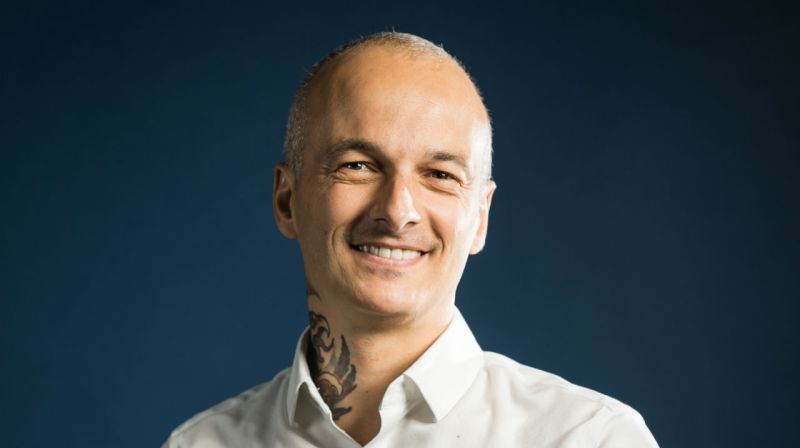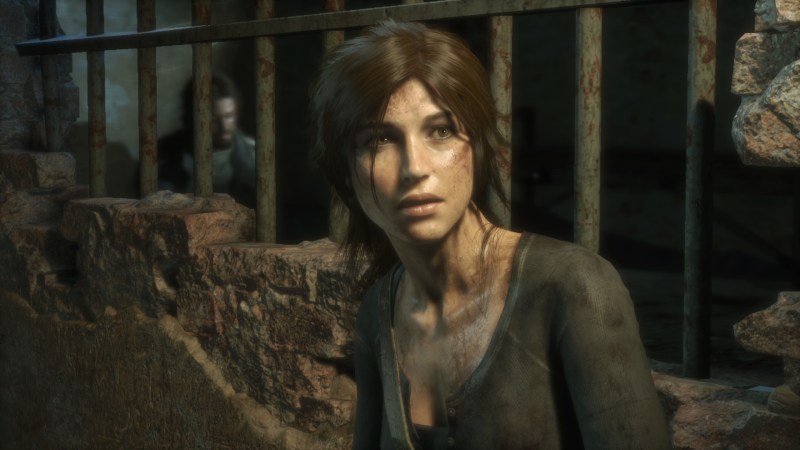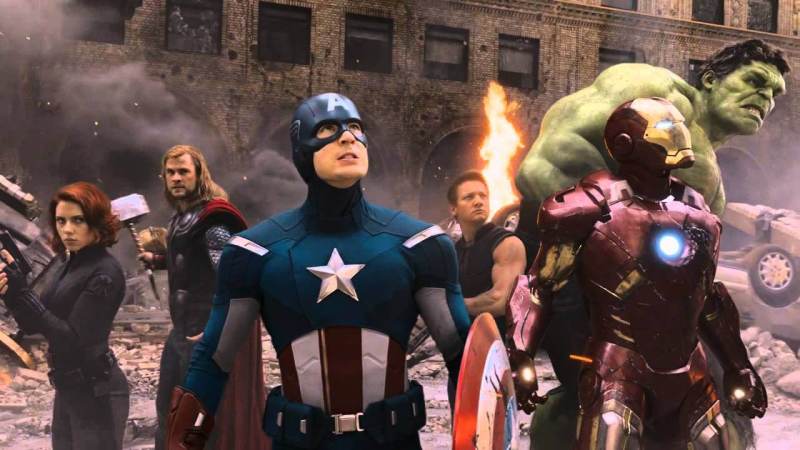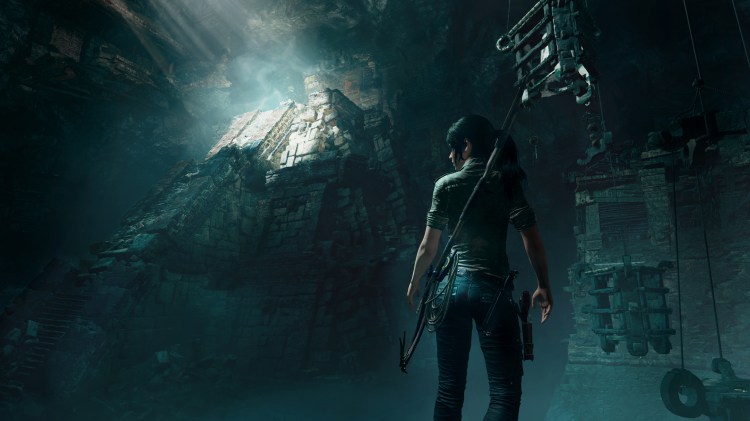Eidos Montreal, the studio making this fall’s Shadow of the Tomb Raider, casts its own striking umbra on the gaming world. Founded in 2007, it opened with an enormous staff and a highly specific goal. With 350 employees in tow, the Eidos Montreal mission was to create dense, story-driven, single-player role-playing games in the then-defunct Deus Ex and Thief series.
In other words, it should have closed almost immediately.
Remember when this happened: In 2007, the high cost of developing HD games was crippling game developers even before the financial crash in 2008. This was also the era when gamers and publishers alike were turning up their noses at single-player games like the ones Eidos Montreal had been founded to make. Who the hell would be crazy enough to make a new Deus Ex when series like Shadowrun were forced to become multiplayer shooters to survive? Eidos itself was in dire straits because of these market conditions. Then Square Enix swooped in to acquire the whole operation, all before Eidos Montreal had shipped its first game.
The studio shouldn’t still be open in 2018, let alone taking over one of the most recognizable characters in the industry. Yet here it is, bigger than ever with 500 employees and with seven years of shipping strong (albeit imperfect) games. Deus Ex: Human Revolution remains one of the best of this decade, and while Thief and Deus Ex: Mankind Divided both didn’t reach that game’s heights, both benefited from the studio’s signature gift for impressive world design.
Now Eidos Montreal is turning to a new series, though still one its deeply familiar with. While Crystal Dynamics has been the face of the open world and shooting-centric modern Tomb Raider games that started with the eponymous 2013 reboot, Eidos Montreal has been assisting with development. With Shadow of the Tomb Raider, those roles have reversed; this third game is an Eidos Montreal project first and foremost, one informed by the studio’s commitment to story and creating complex, explorable spaces. I talked with studio chief David Anfossi about the studio’s recent reorganization, Deus Ex, Tomb Raider, and even Square Enix’s secretive Avengers game.

Above: David Anfossi, the studio head of Eidos Montreal
GamesBeat: What’s going on at Eidos Montreal? This month has been the first announcement of a major game from you guys in years. What’s been going on since Mankind Divided came out?
David Anfossi: Actually, a lot of things changed. The way we manage the studio, for example. We had to admit that since 2007, because we built the studio 10 years ago already—at the time, we had so many things on our plate, with the first game on new technology, building a new team, and with [Deus Ex] Human Revolution.
Three years ago we sat all together and shared our learnings, then looking in front of us to where we wanted to be in five years, 10 years, and we changed a lot of things. At the moment we have three productions at different stages. That’s a big change. Before, it was one production at a time, or maybe two. But now we have three productions, three developments in parallel.
We changed a lot of the structure of the studio, adding different expertises like an R&D department for AI and machine learning, and also on the animation side. A lot of things have changed. With that in mind, we want to be visible and proud more frequently without changing the way we develop games. But we want to be proud more frequently. You saw Mankind Divided in 2016 and two years after we have Shadow of the Tomb Raider. That gives you a good sense of the frequency [we’re aiming for] now.
GamesBeat: The three developments in parallel—I remember, in 2015, you gave me a breakdown of the way the studio worked then: one big major game, but then different parts of the office were working on smaller things to support Square Enix more broadly. You worked on the multiplayer portion of 2013’s Tomb Raider. In this new three-project structure, how is that breaking down? Is it three triple-A projects? Is it three double-A projects?
Anfossi: Of course, our mission to deliver games on console and PC. We have this knowledge about narrative, story-driven experiences. It’s key to keep that. That’s what we like to do. We announced Shadow. We also announced The Avengers, which is a collaboration with Crystal Dynamics. We have a third game development. I can’t speak about this one, because we’re still at an early stage to define the product itself. But it’s definitely triple-A. But we have these incubation projects as well, where we try new things. Whether it’s about content or the way we develop games, it’s some kind of laboratory to test different things.
GamesBeat: Why did you bring in a machine learning specialist?
Anfossi: Machine learning, you can touch a lot of things with that. You can improve your production process, be more efficient. Just to give an example, rendering, sometimes you need a night to render your stuff within the game. We improved that process with machine learning. You can definitely improve your production process. Of course, there’s everything around business intelligence, but also what you can do in a game with NPCs. The AI you’ll face when you play, you can give the player something smarter to play with. We want to try things and learn from that.
GamesBeat: You mentioned before that you still think about story as baked in to the DNA of Eidos Montreal. It’s funny. I was thinking back to the announcement of the studio opening in 2007 when Eidos said, we’re making a studio for role-playing games, for story games, with 350 employees. Even by today’s standards, 350 people is huge. How has that mission changed? If you’re still committed to story at this point, how is that commitment different in 2018 than it was in 2007?
Anfossi: No difference, honestly. Of course, as I said, we have to be honest—I like trying new things. I always wanted to work in the video game industry, but in France in 1995 it was difficult. I used to work for the automotive industry, for a toy company, before I succeeded in entering the video game industry. The experience I keep from that is that you have to be curious and learn from different things. It doesn’t mean that you forget the mission of the studio. It means that you learn things to improve what you’re doing with your games.
If you look at our track record, we’ve been true to the mission since the beginning. Everything we’ve done was about very strong characters, deep universes, complex stories. Shadow is the same thing. There’s no multiplayer in Shadow. It’s all story. It’s all about Lara. It’s about the character. It’s about her evolution. We’ve stuck to the plan. But we’re curious to learn things around that.

Above: Lara Croft in Rise of the Tomb Raider.
GamesBeat: It’s interesting that there’s no multiplayer in Shadow of the Tomb Raider. I know that you were very proud of the work you did on the multiplayer portions of Tomb Raider 2013 and Rise of the Tomb Raider. You were given something that the audience wasn’t necessarily expecting to have, and you did something good with it. Why was the decision made to skip multiplayer this time?
Anfossi: On Rise we didn’t do multiplayer. We worked a lot on the single-player experience, the R&D around that, and all the cutscenes. It was story-driven on our side, which is very important. And also, we weren’t the leaders on the two previous games. We were in collaboration with Crystal [Dynamics]. It was key for us to learn about this franchise, from them, how to deal with the Tomb Raider franchise. That’s why we’re comfortable now to lead the third one, because this experience is shared between both studios.
Every game, we learn things. You read postmortems. You listen to gamers, what they like and what they don’t like. What you keep, what you improve, everything. We want to make sure that we close this story with the third game of the trilogy. It’s as simple as that.
GamesBeat: At what point was it decided that you guys were going to take over the story from Crystal Dynamics? How did that happen?
Anfossi: It’s still a collaboration. They worked with us at the beginning. They have strong experts over there to make sure we respect the law of the franchise. We respect the relationships between the characters, that kind of stuff. But it’s just a question of timing, actually. They delivered—we delivered, actually, Rise of the Tomb Raider in 2015. This partnership with Marvel arrived around that time, and they were free to start The Avengers. It was a question of timing. We were ready on our side. We worked on the previous games. We were definitely ready to lead a Tomb Raider game. It was good timing for everybody.
GamesBeat: What’s your process with Crystal Dynamics like. It’s rare for two really big studios that fall under one publisher to have such an intimate relationship. Usually things are a bit more segmented, or you have multiple studios where one does asset production and nothing else. It seems like your relationship has been more creative. How do Eidos Montreal and Crystal Dynamics coordinate on a game? Are certain things just owned by one studio or the other and you meet in the middle?
Anfossi: We’re very far from each other, so there a lot of logistics in place, good processes. We have to be rigorous. We have a specific setup. Every day we have a video conference call to make sure we’re on the same page. But the good thing is that, because it’s two different studios with two different, I believe, expertises or strengths, we’re able to complement each other.
I’m not saying it’s easy to work at a distance. Even here, we have two different flows for Eidos Montreal. You have to add more communication and everything. It’s just a question of working together, learning the right processes, and making sure that we exploit the strengths of each studio. By doing so, I believe that we’ve been successful with the reboot of the Tomb Raider franchise. It’s the same thing with The Avengers.
GamesBeat: How did the studio handle when Shadow of the Tomb Raider leaked in 2016?
Anfossi: Honestly, we have a very strong process regarding the confidentiality, security access and everything. You can’t work with Marvel, for example, if you don’t have that in place.
GamesBeat: Does Disney actually send Stormtroopers at this point?
Anfossi: [Laughs] Very funny. But no, we didn’t change anything. We have this guy—while working hard on the project, walking in the subway and everything, he made a mistake. But that didn’t change anything. The process in place is very strong. There’s no damage in the end. No content actually leaked whatsoever.

Above: Deus Ex: Human Revolution marked Eidos Montreal as purveyors of story and exploration
GamesBeat: Everybody is still dead curious about what this game is going to look like. I’m very curious about what this game is going to look like coming after Tomb Raider 2013 and Rise of the Tomb Raider. Both of those games stepped very far back from the puzzles and exploration that were the signature of the old Tomb Raider.
I was excited to hear you guys were working on Shadow the Tomb Raider, because Eidos Montreal has made very puzzle- and exploration-centric games. In Deus Ex: Mankind Divided and Human Revolution, 90 percent of your time is spent trying to pathfind, to solve problems. Combat has always felt almost secondary in Eidos Montreal’s games. How is that tradition being leveraged in Shadow of the Tomb Raider? Is this still going to be primarily a gun game, or is it going to be somewhat more of a classical Tomb Raider?
Anfossi: You have to respectful of previous games. You don’t want to change everything. You have to make sure that the gamers who played the first two games are comfortable and understand what’s happening with whatever control mappings or what’s happening on the screen. But it was clear for us that we wanted an Eidos Montreal signature on this.
We’re good, I believe, at conveying story to gamers. It will be very story driven, very character-centric. We spent a lot of time and hard work on Lara. The traversals and platforming are amazing. We’ve brought some fresh mechanics to that.
Show don’t tell. In Deus Ex, when you meet a character, their environment is very specific. The audio is very specific to them. Their clothing is very specific. Because it’s show don’t tell. Your subconscious catches these details. The atmosphere and immersion are better because of that. That’s the kind of technique we learned from Deus Ex and that we implemented in Shadow. We’ve brought our signature to Shadow. It’s very specific, but at the same time very respectful of the trilogy, I think.
GamesBeat: I’m curious about how the story for this was written. You’re one of the few studios out there in the triple-A space that has an in-house writing team that’s permanent. Previously, the story was contracted out on the Tomb Raider series to Rhianna Pratchett. How has the writing been done on Shadow of the Tomb Raider?
Anfossi: Mainly here at Eidos. As you say, we have this expertise. We have very talented guys, able to develop characters and create strong stories. Of course, we worked with Crystal and the external experts who developed the story for the two previous games, to make sure we respect that and we’re in line with what was the initial plan on the story side. But yes, as you say, we have this expertise. We want to be in control. We totally trust the guys here.
GamesBeat: Are you guys also doing all of the performance capture for the game? I know you have a motion capture studio in-house. I know that Crystal Dynamics had previously built a whole process for making cutscenes.
Anfossi: We have a motion capture studio here in the studio, so we can do, I would say, 90 to 95 percent of all the performance capture here. When I say “all,” that’s facial, body, and audio at the same time. We’re a bit of control freaks. We want to make sure we can deliver the quality we want and we expect for this game.
But like the previous two games, we work with Camilla [Luddington] for Lara. It was easier for us to do like Crystal did with the previous games and do the capture in Los Angeles for Lara, to make sure we’re on site and it’s easier for Camilla.
GamesBeat: I’m curious about that feeling that you can’t change things too dramatically, because you have your third game into a franchise that has all of this baggage from before. You have all of these different audiences that need to be satisfied when they see the words “Tomb Raider.”
In your previous games like Deus Ex you were taking over a series, but it was very much a reboot. You guys were re-creating this thing for a modern audience. At this point, that world feels like it’s yours. Tomb Raider isn’t Eidos Montreal’s. You’re taking that baton and running with it.
What are the specific challenges that come up when you’re developing something that you didn’t own previously?
Anfossi: We proceeded the same way we did for Deus Ex or Thief. You do your homework. For example, on Human Revolution, even before we started the conception, we played the first two games, just to make sure we perfectly understood the essence of the franchise, the pillars of it, and we built on a solid foundation, but a respectful foundation. After that you put your signature to it.
Because we had this collaboration on the two previous games, we had learnings. We had time to learn and make sure we totally understood the franchise. Knowing these foundations, we’ve been able to put our signature to it. All the themes, the setting, the combat—as I said, we decided what kind of pillars we wanted for this third game.
It would be different for a new IP, of course, because you start with a white sheet. Because this is a well-known franchise and there are two previous games, we have to work like that.

Above: Eidos Montreal and Crystal Dynamics are hard at work on The Avengers
GamesBeat: Tomb Raider 2013 was widely adored. Critical praise across the board, fan praise across the board, it was an unmitigated success. Rise of the Tomb Raider has had a more a tepid response. People have seen Rise of the Tomb Raider as good, but not as good.
How do you go about designing a game that’s going to win people back?
Anfossi: Good question! [Laughs] We could definitely compare Human Revolution with Tomb Raider 2013. You bring something fresh and unexpected by gamers and journalists and the industry. You create a kind of surprise, a positive surprise. After that, it’s more complicated to surprise gamers. That’s where there’s a challenge. I totally agree with you, and especially for a third game. But I believe that—maybe you should stay tuned for E3. You’ll understand what we did to make sure that there’s something new and very interesting and, I believe, surprising for Tomb Raider fans. But you’re right. It’s a big challenge to be the third game or the second game. Definitely a challenge.
GamesBeat: I was reading a statement that you made this past December, where you were talking about how Eidos Montreal is going to be focusing on online experiences. The exact quote was: “We’re placing an added emphasis on the online experiences in our games, striving to continually provide players with content that is memorable and impactful.”
In the past, for a triple-A studio taking on a traditionally narrative-based IP, that online experience translated to a multiplayer mode. That’s clearly not the case with Shadow. What does focusing on online experiences mean for a game like Shadow of the Tomb Raider?
Anfossi: You’re right, we’ve added some focus on that. That’s the right wording, and we’ll insist that we keep narrative and story key, at the center of the experience. That’s what we like to do. But online doesn’t mean multiplayer. It doesn’t mean co-op. It could mean single-player as well. It could mean a lot of things.
As I said, I’d like to try things—we have incubation projects, things like that. It’s all about that, honestly. There is nothing especially for Shadow or for our current developments around that. We want to learn. Like we discussed about AI. AI could mean a lot of things, as we say. It could be focused on process efficiency. It could be focused on in game experiences, whatever. You have to learn. The status quo isn’t viable for us. We have to learn. We have to adapt. After that, I’ll stick to what I said. It’s all about delivering better quality in the end.
GamesBeat: I have to ask about Avengers. What can you actually tell me about Avengers?
Anfossi: [Laughs] No, I cannot say anything about that. We have 50 developers here at Eidos, working on the collaboration with Crystal Dynamics. I’m very happy about the partnership with Marvel. It’s something we initiated here at Eidos, something we wanted to try, in the sense that—we wanted to develop this partnership with them and work together and see what’s happening with that. I’m very excited by that. That’s all. That’s the only thing I can say.
GamesBeat: If there’s somebody out there who loved Tomb Raider 2013, but they dropped off with Rise, what is one thing that you want to tell them to get them really excited about Shadow of the Tomb Raider.
Anfossi: The puzzles are just crazy. There are more puzzles. They’re huge. They’re very satisfying. A quick anecdote. We have here a crazy designer who ensured that all these crazy puzzles could be a reality. The mechanisms around it, how it works, it’s totally realistic and totally crazy. But the puzzles are huge, very interesting. There’s more of that. So just for that, we’re back to what, as a Tomb Raider gamer, I liked to play.
GamesBeat: Is your designer, Jonathan Jacques-Belletête, behind this? Or is it somebody else at the studio?
Anfossi: It’s somebody else.
GamesBeat: Who is it? Who’s the one driving the puzzle design?
Anfossi: I’ll keep it a secret. I don’t want reporters to come after him.
GamesBeat: When are we going to see Adam Jensen again? Is he taking a long rest, or are we going to see him again?
Anfossi: Deus Ex is very important for the studio. Honestly, truly, sincerely. We built the studio with this franchise and with Adam Jensen. It’s just that—you know, as you said, we’re a big studio. We’re close to 500 people now. But at the same time, we have three developments in parallel. We have to make sure we deliver the quality we want. No compromise on that.
When it will be the time for Deus Ex, it will be the time, and we’ll do it correctly.

